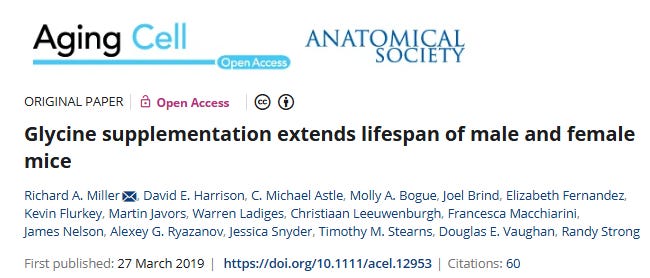I used to think collagen was just another wellness buzzword—something Instagram influencers stirred into their oat milk lattes to stay “glowy.”
But then I had a bowl of pho.
Not just any pho—the kind that simmers bones for 24 hours, where the broth is rich, unctuous, and feels like it’s doing something to your soul. That’s when it clicked: this wasn’t just comfort food. It was chemistry.
Collagen—and its powerhouse amino acid, glycine—aren’t just for beauty. They’re for repair. They’re the quiet builders that hold your body together, regulate inflammation, improve sleep, and maybe even stretch your lifespan.
Turns out, what’s in your soup might be one of the most underrated longevity levers we have.
Let me explain.
Collagen & Glycine: The Structural Duo That Holds You Together
Your body is basically built on collagen. No exaggeration. It makes up 25–30% of your total protein. It’s the scaffolding in your skin, bones, ligaments, cartilage—even your blood vessels.
And its secret sauce? Glycine.
Glycine is the smallest amino acid, but don’t let that fool you. It’s what allows the collagen triple helix to twist tight and stay strong under pressure. Think of it like the ziptie holding your structure together—compact, essential, and weirdly powerful.
Glycine is “non-essential,” meaning your body should make enough of it on its own.
Spoiler alert: it doesn’t.
The Silent Glycine Deficiency (Nobody’s Talking About It)
Turns out, humans (and rats and pigs, for that matter) can’t synthesize enough glycine to meet metabolic demand—especially under stress, inflammation, or aging.
So what happens when you’re running low?
Weaker immune function
Slower repair of tissues and joints
Disrupted metabolic balance
Poor sleep
Gut barrier breakdown
And you might not feel it until something breaks!
But here’s what shocked me most: Glycine isn’t just a “supportive” amino. It’s a regulator. It builds glutathione for detox. Boosts neurotransmitters like GABA for sleep. Helps your pancreas manage insulin. Even seals your gut lining.
It’s the quiet conductor behind the scenes.
What Happens When You Put Glycine Back In?
Lab studies show glycine can do wild things:
Reduce blood sugar spikes
Improve cholesterol and triglyceride levels
Tame liver inflammation and oxidative stress
Help you sleep deeper
This is foundational repair, not symptom suppression.
Collagen Peptides = Glycine in Action
Collagen is how you deliver glycine. When hydrolyzed into peptides, it’s easily absorbed and gets to work fast—building skin, joints, bones, and connective tissue.
One study even showed that postmenopausal women taking collagen peptides increased their bone density (König et al., 2018). That’s not just cosmetic. That’s structural integrity.
In another trial, Type I collagen peptides helped reduce eye wrinkles by increasing skin elasticity within 8 weeks (Zhao et al., 2021). Form meets function.
And here’s the part that flipped a switch for me:
Mice given extra glycine lived longer—up to 25% longer, depending on dose. They also stayed leaner and showed lower inflammation!
That’s not a typo. One amino acid. Longer lifespan.
It’s like the body breathes a sigh of relief when you give it back the building blocks it’s been scraping for.
How I Rebuilt My Collagen and Glycine Reserves
After reading the research, I changed a few things. Nothing extreme. But the results? Better sleep, more resilience, clearer focus.
Here’s what worked:
🍲 Bone broth – Best source is always natural. Rich in glycine and minerals. Pho up your dish.
💧 Collagen peptides – 10–20g/day.
😴 Glycine powder – 3g before bed = deeper sleep.
🍊 Vitamin C from fruits– Critical for collagen synthesis. Don’t skip this.
🍮 Homemade gelatin snacks – Yes, really. They’re delicious and therapeutic.
Collagen rebuild works best when you stop doing things that break it down—chronic stress, processed food, lack of sleep, and toxin overload.
Inflammation is the enemy of regeneration. Lower that, and everything else starts to click.
Final Thoughts: The Protein That’s Also a Signal
The more I learn, the more I believe glycine and collagen are more than just nutrients. They’re messages—telling your body it’s safe to repair, rebuild, and regenerate.
That’s powerful.
In a world obsessed with hacks, sometimes the key to feeling younger is ancestral: broth, rest, and the right proteins.
So if you’re tired, inflamed, or just feel off?
Start here. Reinforce the scaffolding. Because when your structure’s sound, everything else—mood, energy, recovery—has a foundation to rise from.







